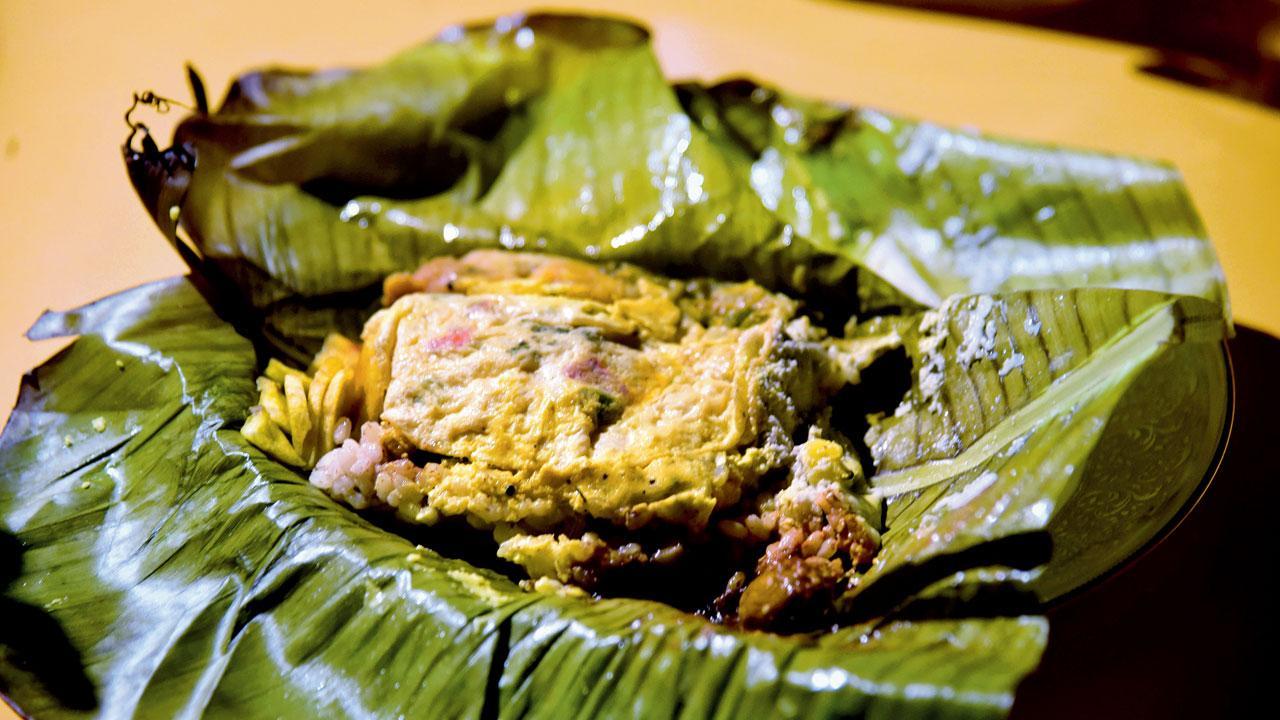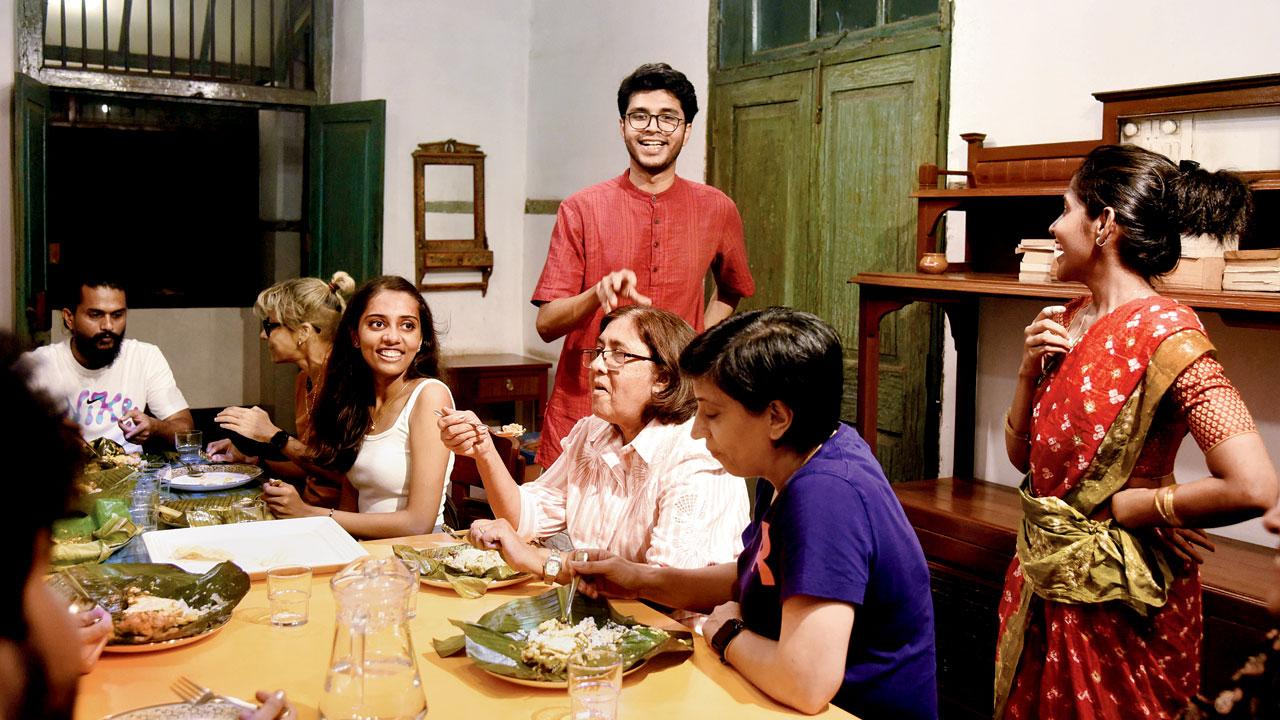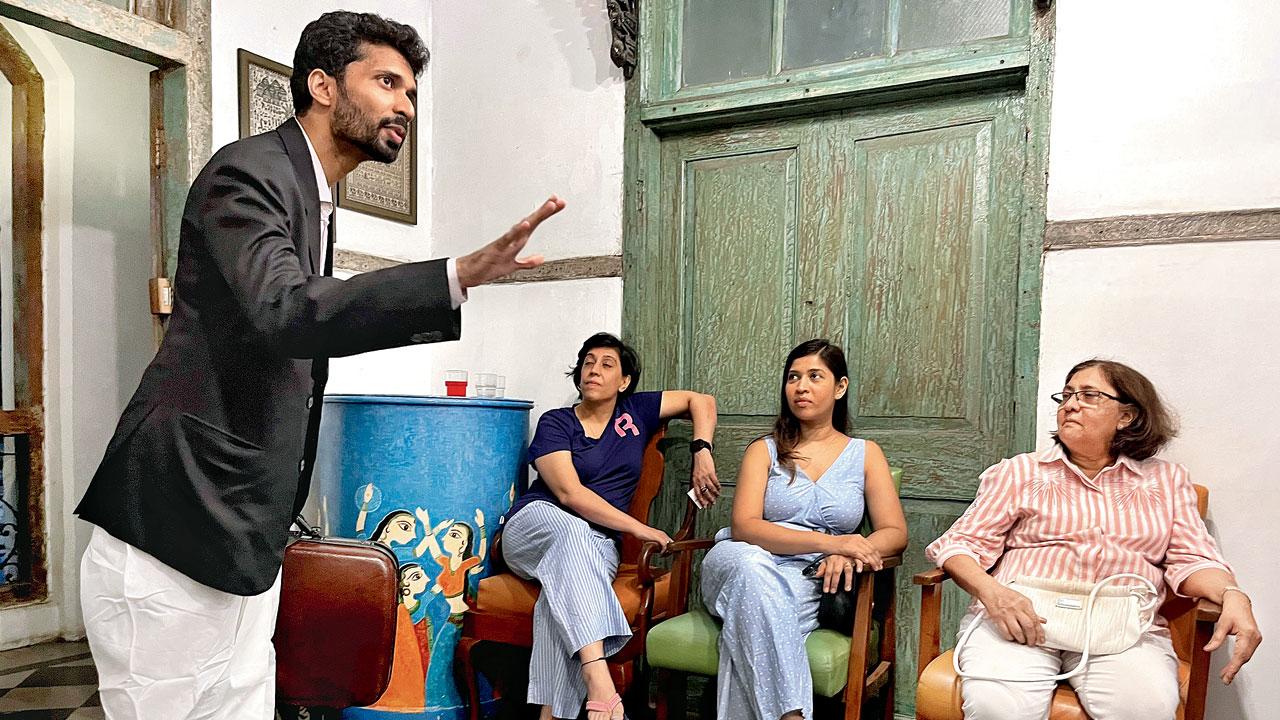Set in the 1950s, this immersive dining experience invites you to explore a bygone Bombay, and dine in a story

Poti choru
Meet us at the Crawford clock tower, they said. Heads up: There are no lifts; you must walk up three flights of stairs and wear comfy shoes. The bustling bazaars of Crawford market often seem like it is stuck in time; and now, we were invited to enter another era.
ADVERTISEMENT
New India Lodge, Bombay. Circa 1950. You enter a time capsule of a freshly independent India. It is an interesting transient moment of meeting fellow travellers from different cities. The lodge master, a Mangalorean serves a welcome drink that’s quintessentially Bombay (hint: it’s something berry). Somewhere in the story, you encounter a well-travelled man, carrying a famous food item from the outskirts of Bombay. A fusion dessert can be made with it. Alongside, you meet two businessmen from Gujarat with extreme opposite food preferences.

Immersive theatrical dining is an experience that stays with you long after the meal is over. Pics/Atul Kamble
Surti locho is served with farsan for vegetarians and gustavo (shredded mutton) for non-vegetarians. Both have a story. Divya Rani, director and producer of this theatrical dining experience explains, “Locho becomes a bone of contention between the two friends, arguing about veg and non-veg food, with an underlying message of the freedom to eat what one wants. Considering the current political situation, that hasn’t changed much since the 1950s, but it’s a light-hearted, fun take on it. If I want to put farsan on it, good for me and if you want to put it over gustavo, it should be very okay. Woven into the narrative—you understand people, their origins, their choices, and why they eat what they eat.”
You’ll also meet a couple travelling with their child serving pothichoru, a great railway or travel meal, wrapped in a banana leaf. It signifies the dreams of a well-educated lady, who, after she is married doesn’t know what an ambition or a career looks like—there haven’t been enough role models. She talks of the nine different items in the dish and how each one reflects her childhood, reminding her of characters from her life, and how, now she can only have these lovely dreams for her daughter. Lastly, there is sevaiya kheer from Punjab with makhana (fox nuts), nariyal (coconut) and chuuara (dried date), and all of these are important in the story about a wife who lost her husband during the Partition and is trying to find him, moving from city to city.

Characters of the play share food and entwine it with the plot of the story
Beautifully performed in rhythms and meter, food is treated as an actor. “It denotes what a young, independent India holds for a single woman and what it means to someone who lost everything. Freedom comes with repercussions; how that plays out for someone, makes the story interesting,” says Rani. For writer Shubhra Chatterji, the idea of the immersive dining experience started with wanting to pace this around a traveller’s lodge where people from different walks of life share time, space and food. The period came in later. “It was a blank canvas; slowly things started building. We focussed on travel food.
What is it that people eat when they travel?” she adds. Chatterji’s experience of working on Station Master’s Tiffin, a food show that had her travel around the country shooting the food served on trains and what’s available at the stations, made it easier to make food the real shining star in the play. “I love the 1950s-’60s. India was at an essential point in her journey, and personal stories from my grandparents, who had to flee from Lahore on a train, came in handy for absolute references.
Inspired by period cinema, the music and costume references are integral parts of the experience. The story covers different themes—some we are still grappling with—gender and food politics—and is sublimely embedded in the story and characters. The more significant idea is that of freedom—of choice and expression. As for food, dishes with exciting stories of origins were picked. “We chose food stories that need to be told; unfortunately, the courses are limited, but we will add more later,” says Chatterji. Most days, they are a part of the story, asking them to move things around and assist characters, move furniture, or ask them questions. As the main characters talk to you, other characters are sprinkled in the plot, reacting to the story and conversing with you. It’s not one way. Immersion is created.

Shubra Chatterji and Divya Rani
For Rani, the idea of immersive theatre came about in 2018 while visiting her sister in Mumbai; Rani got bored—there weren’t any good movies running, restaurants were monotonous, and clubbing had lost its charm for her. “I wanted to go to a place where I could feel inspired, so I started penning down what I’d like to do. I love listening to stories, and I love food, and that was this whole Ikigai—light on—moment for me. So my favourite memory of eating is when I was in nursery. Every time the lunch bell went off, all the little tots would usher in this huge lunch room where there was a long community table, and we all put out our tiffins; that was such a pure memory because there was no sense of separation based on where you came from? What do your parents earn? If you ate veg-non-veg, which religion did you belong to—these were just a bunch of kids, happy to put their hands into the tiffin, depending on how yummy or yucky that thing looked. I wanted to recreate it,” she adds.
Inspired by the supper clubs of London and the theatrical dining scene of New York, Rani started paChaak productions to entwine stories and food. “India doesn’t have any dearth of good cuisine or stories, and I wondered why people weren’t doing something like this here.” That’s how she started bringing different creative minds—from the storyteller to the actors and the chefs—to come together and innovate.Most days, it is discussing what the chef is making, what ingredients can they source, what’s the speciality of that dish, and how can it be brought into the story by the storyteller and vice versa.
Then there are the actors trying to bring this to life, imbibing the era and telling you the story of both the food and the plot—it’s a great jugalbandi of sorts. The space is the third pillar, creating an immersive experience for the guests. “It’s about time we stop living in silos. The thing about a drunk alcohol party is that you forget that you met these amazing people and had a great conversation, and the next day, you are back to square one. Here, you are truly immersed in a multi-sensorial experience,” says Rani.
 Subscribe today by clicking the link and stay updated with the latest news!" Click here!
Subscribe today by clicking the link and stay updated with the latest news!" Click here!








